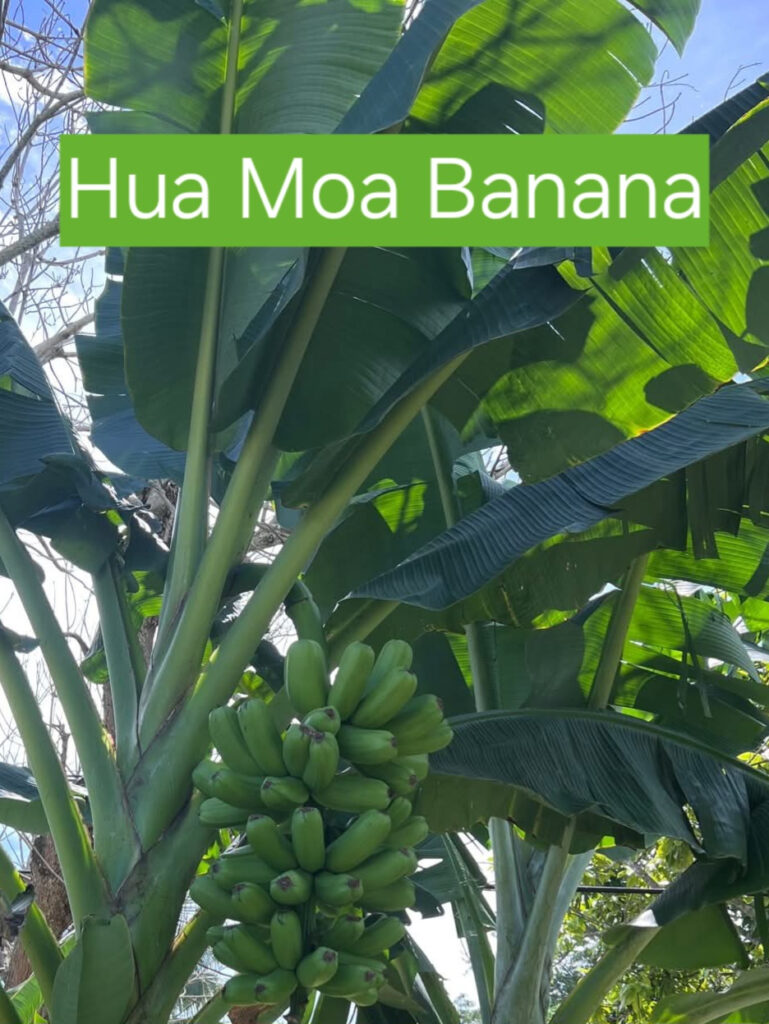S & J Nursery’s Guide to
Growing Hawaiian Hua Moa Banana Plants
in Northeast Florida Gardens
Hua Moa Banana Plants For Northeast Florida Origins:
Hua Moa is a banana plant native to Polynesia and a very popularly grown and distributed banana selection in Hawaii. Its AAB genetics (getting two chromosomes from acuminata and one from bulbisiana ) give it both sweet and creamy flesh and a lower resistance to cold climates. It can be reliably cultivated in grow zones 9-11 and tends to like hot humid climates. In general Banana plants follow the chart below
Temperatures below 60 F =Growth slows
Temoeratures below 50F = Growth stops
Temperatures below 32F = chilling damage can occur on fruit and stems of established plants, short periods of cold even down to 30 degrees sometimes don’t show outward signs of damage to the stems, the foliage takes some damage. Longer duration under these temperatures results in visible damage to leaf blades and stems.
Temperatures below 28 F = above ground portions killed off to the ground. Within 2-3 days of the freeze the pseudostem ( trunk like portion of the plant) and the leaf blades ( the big showy leaf portion) will begin to brown and turn wet and mushy looking. The plant will regrow from the underground portions when temperatures warm.
One of the reasons Huo Moa is so beloved is it is a short cylcle banana meaning it goes from planting to fruiting very quickly in as little as a years time it can bear fruit, which would normally make it ideal as an option in NE Florida ( if it was an ABB variety getting more chromosomes from the more cold tolerant bulbisiana banana) With Hoa Moa it seems that pseudostem damage resulting in slower fruit formation can occur at about 40 degrees. So here in NE Florida it may produce more like other banana varieties. Indeed there are many home gardeners who get fruit production in N Fl, I do assume however that they are paying good attention to their sites individual microclimate and planting in areas like the south side of the house or fence or shed, or the south side of a large tree to keep it our of north winds etc. So in my opinion, unlike a banana plant like say Orinoco that I just stick willy nilly anywhere I want a banana plant to grow, these really do need some thought as far as placement in the garden. Look for frost free areas of the garden. During winter in the early morning when there is frost on the grass there will be areas that the frost has not settled on, those are your warm spots for tropical plantings and I would, based on what Ive heard and my own personal experience with newly planted Hoa Moa, that’s where I would be planting this variety, hedge your bets so to speak and see if you can get annual production out of these guys.
Bananas are an herbaceous plant and although most commonly referred to as a tree the “trunk” of the plant is a collection of the bases of the large banana leaf stalks. The stem portion of the leaves wrap tightly togethe/r to form what is called a pseudostem that we think of as the “trunk of the tree”

Sun Exposure for the Hoa Moa Banana plant :
In Northeast Florida, plant Banana plants in a full sun or partial shade location preferably on the south side of the home and away from frost prone areas of the landscape and high winds that will damage the foliage or break fruiting stems.
Foliage and Plant Height of the Hoa Moa Banana Tree / Plant:
Hoa Moa is a medium to large banana plant selection with bright green leaves that gets 8-10 ft stems. (banana height is measured to the top of the pseudostem)
Soil Preference for the Hoa Moa Banana for Northeast Florida:
When it comes to planting banana’s in Northeast Florida I can not say this one thing enough, compost, compost and more compost! In fact the healthiest, best producing banana plants I have ever seen are growing right out of the compost pile on our tree farm in the Switzerland area of St. Johns county Florida.
Amend your soil generously with compost when planting banana plants. Dig your 3 ft by 3 ft hole or even bigger if you can, and back fill the area around your new banana plant with 50 percent compost and 50 percent native soil that you removed from the hole while digging.
Be sure to locate your banana in an area where it can receive supplemental irrigation and away from flood prone areas of your landscape. Banana’s need moist but well draining soils.
Pruning Hoa Moa Plants for the Northeast Florida Landscape:
Banana plants form clumps by sending up suckers off the rhizome that forms underground. The main stem will die after flowering and forming fruits and the side shoots will replace it. As mentioned above that stem is composed of tightly packed layers of leaf bases. As the new leaves emerge from the center of the stem older leaves are pushed outward with the oldest set of leaves ( the ones on the bottom) eventually browning and hanging down from the tree. It is debated wether trimming those leaves is best for the tree or leaving them on is best. Some argue removing older leaves removes frost prtection to the stem that that hanging foliage would give it during winter, some argue that removing spent foliage increases air flow to the foliage and stems giving the trees better resistance to fungal pahtogens that can damage or kill banana plants. Some say they get better wind resistance when they leave the old leaves on the tree it seems to make the stem stockier or sturdier, some remove all leaves except the center ones when a strong storm is coming through. I feel like everything is relative, what one gardener experiences with any plant is not what another gardener experiences. Everything matters, placement, soil drainage, soil composition, wind exposure, sun exposure. etc it all adds up. A banana plant that is getting all afternoon shade in an area that holds water after heavy rains is not going to have the same battles as a banana planted in an area where its full sun, super sandy soil and experiences a wind tunnel from neighboring house placement channeling wind right to it. The ame thing goes when you ask people if you need to remove the banana pups growing up around your main stems. Some people want to maximize the fruit production to its peak and will leave one grandmother tree that will produce this season one mother tree that will produce next season and one baby pup for the year after that in succession each year and some people, like myslef leave them to grow as they are unless dividing for additional plantings or to give to friends. Either way you choose to do it, its OK ITS YOUR BANANA PLANT! And remember EVERYTHING IS RELATIVE so take it easy and get to know your sites specific challenges, then do what works best for you. Below is a general guide.
After flowering and fruiting, prune out the center stem that has died and leave one to three well spaced stems that are directly connected to the main stem to grow up and replace it. Leaving to many suckers to grow can result in poor or slowed fruit production. Commercial growers tend to stick to the group of three generations for the fastest fruit forming.
IMPORTANT: (Be careful when choosing which sucker to leave get to know the difference between water suckers and sword suckers. Water shoots (a sucker close to, but only superficially attached to the main stem) that will emerge at a distance from the main stem are not as productive and should always be removed, only keep shoots that are directly connected to the flowering base.)
Blooms and Fruit of Hoa Moa Banana Plant for Northeast Florida Landscape:
Hoa Moa banana plants are renowned for their unique and versatile tasty fruit. They can be eaten raw when they have begun to spot up some on the peel and they particularly hold up a true banana flavor when cooked making them extremely useful for things like an excellent tasting banana bread! Unlike many banana selections its not “either or” with Hoa Moa you get the best of both worlds! The fruits tend to be not very starchy and are said to make a nice crisp chip when fried green as well!
Hoa Moa fruits are extremely gurthy, while they may be a similar length to the grocery store Cavendish banana varieties they are 2-3 times as wide and really make an unusually shaped fruit. Hoa Moa produce sweet creamy fruits that can weigh as much as .8- 1lb each! And can get as large as 10 inches in length and 4 inches in diameter. Each stem on Hoa Moa banana can produce 4-8 hands although each hand will have fewer but larger fruits.
Water and Fertilizer Requirements of the Hoa Moa Banana Plant:
Banana plants grow quickly and require allot of water and fertilizer to sustain that tremendous growth.
Water daily after planting your newly planted banana from and S & J Nursery container for the first two to three weeks being sure to supply your new plant all the water it can possibly need to get growing. Taper your water back to every other day then every third day then to once a week making sure to supply at least an inch to an inch and a half of water each week during the growing season.
The fertilizer recommendation varies depending on what professional you talk to, I guess we all have our opinions and what works best for us, we continue to use and recommend to others. Some recommend a fertilizer N-P-K ratio of 3-1-6 ( your fertilizer bag would say 6-2-12 or a similar ratio to 3-1-6) Others say to use a well balanced plant food keeping the N-P-K ratio at around 8-10-8. And then other garden authors say to use a 6-6-6 fertilizer.
One theme is constant among them all…fertilize frequently and heavily! Some recommend monthly some every other month, but all will tell you that bananas are heavy feeders and a mature banana plant may require as much as 1-2 lbs per application! Start with 1/4 of a lb on small plants and increase the amount applied monthly as the plant grows.
You may be able to locate a fertilizer formulated specifically for tropical plants or banana plants, I have been using the Sunnyland Citrus and Tropical Plant Food fertilizer mixed with a manure based compost on mine and get good results.
Harvesting your Banana Plants Fruits:
Banana fruits mature slowly on the tree, some taking months after forming before the first hand begins to show any yellowing. Be sure to leave the fruit on the tree until you see the first set of bananas start to show some color before removing them from the tree to allow them to finish ripening indoors.

